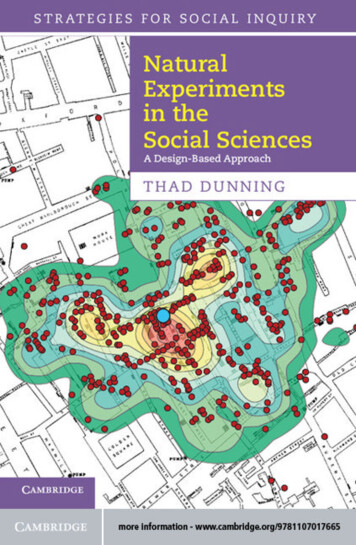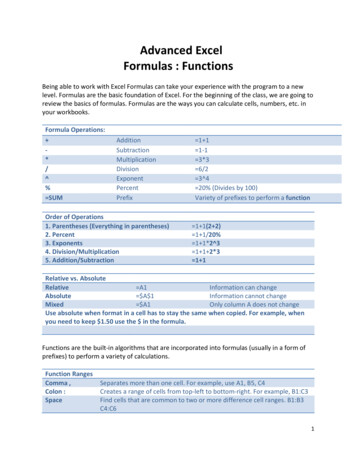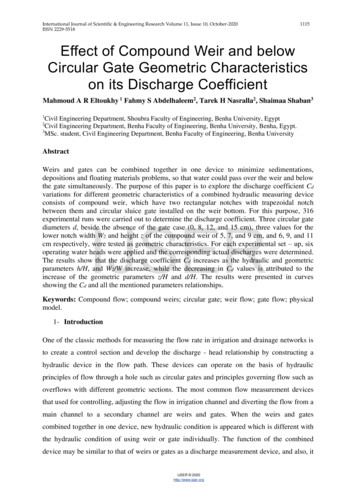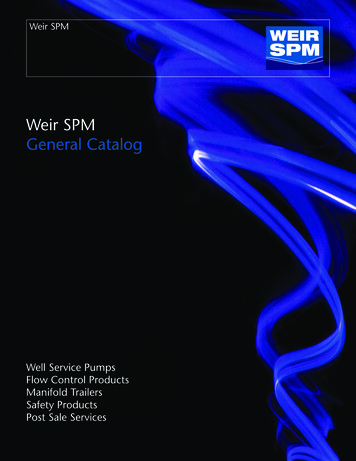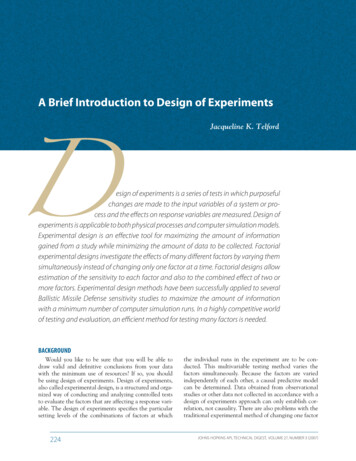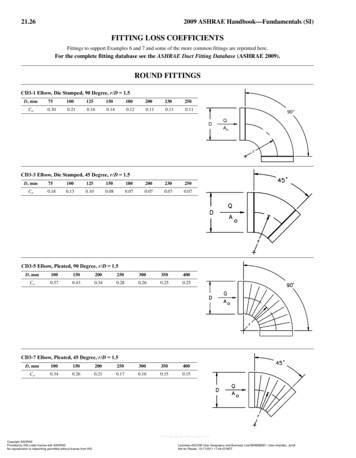
Transcription
Water-Supply and Irrigation Paper No. 200Series M, General Hydrographic Investigations, 24DEPARTMENT OF THE INTERIORUNITED STATES GEOLOGICAL SURVEYCHARLES D. WALCOTT, DlRECTOEWEIR EXPERIMENTS, COEFFICIENTS,AND FORMULAS(REVISION OF PAPER NO. ISO)BYROBERT E. HOUTONWASHINGTONGOVERNMENT PRINTING OFFICE1907
Water-Supply and Irrigation Paper No. 200Series M, General Hydrographic Investigations, 24DEPARTMENT OF THE INTERIORUNITED STATES GEOLOGICAL SURVEYCHARLES D. WALCOTT, DIRECTORWEIR EXPERIMENTS, COEFFICIENTS,AND FORMULAS(REVISION OF PAPER NO. 15O)BYROBERT E. HORTON-WASHINGTONGOVERNMENT PRINTING OFFICE1907
CONTENTS.Page.Introduction.Definitions of terms .Notation.Base formulas.Equivalent coefficients.Approximate relative discharge over weirs.References. . .Theory of weir measurements .Development of the weir . .Theorem of TorricellL.Elementary deduction of the weir formula . .Application of the parabolic law of velocity to weirs .General formula for weirs and orifices .Vertical contraction .Velocity of approach .Theoretical formulas.Distribution of velocity in channel of approach.Distribution of energy in channel of approach.The thin-edged weir.Earlier experiments and formulas .Castel.-.-.----.-.Poncelet and Lesbros.Boileau. .East Indian engineers' formula.Experiments and formula of James B. Francis . .Experiments and formula of Fteley and Stearns.Bazin's experiments.Bazin's formulas for thin-edged weirs.Derived formulas for thin-edged rectangular weirs.Fteley and Steams-Francis formula.Hamilton Smith's formula .Smith-Francis formula.Parmley's formula .Extension of the weir formulas to higher heads .Comparison of weir formulas.Comparison of various velocity of approach corrections.End contractions incomplete contraction .Compound weir. .Triangular weir.General formula .Thomson's experiments 3134343437373940404446464646
4CONTENTS.The thin-edged weir Continued.Page.Trapezoidal weir . .47The Cippoletti trapezoidal weir .47Cippoletti's formula.48Requirements and accuracy of weir gagings .49Precautions for standard weir gaging.49Plank and beam weirs of sensible crest width .52Reduction of the mean of several observations of head.52Effect of error in determining the head on weirs.53Error of the mean where the head varies .54Weir not level .57Convexity of water surface in leading channel.58Results of experiments on various forms of weir cross sections.59The use of weirs of irregular section .59Modifications of the nappe form .60Experimental data for weirs of irregular cross section .61Base formula for discharge over weirs of irregular cross section .62Bazin's experiments on weirs of irregular cross section.63Bazin's correction for velocity of approach .63Recomputation of coefficients in Bazin's experiments.66Cornell University hydraulic laboratory .85Experiments of United States Board of Engineers on Deep Waterways.86Experiments at Cornell University hydraulic laboratory on models ofold Croton dam .90Experiments of United States Geological Survey at Cornell Universityhydraulic laboratory.95Experiments on model of Merrimac River dam at Lawrence, Mass.107Flow over weirs with broad crests .110Theoretical formula of Unwin and Frizell.110Blackwell's experiments on discharge over broad-crested weirs.112East Indian engineers' formula for broad-crested weirs.114Fteley and Stearns experiments on broad- crested weirs.116Bazin's formula and experiments on broad-crested weirs.117Experiments of the United States Geological Survey on broad-crestedweirs.119Table of discharge over broad-crested weirs with stable nappe.121Effect of rounding upstream crest edge.122Experiments on weirs with downstream slope or apron of varying inclination .124Triangular weirs with vertical upstream face and sloping aprons.124Triangular weirs with upstream batter 1:1 and varying slope of apron.126Experiments on weirs of trapezoidal section with upstream slope ofJ:l, horizontal crest, and varying downstream slopes.127Combination of coefficients for weirs with compound slopes .127Weirs with varying slope of upstream face .128Dams of ogee cross section, Plattsburg-Chambly type .130Experiments on discharge over actual dams.131Blackstone River at Albion, Mass .132Muskingum River, Ohio.132Ottawa River dam, Canada.132Austin, Tex., dam.133Roughness of crest. .133Falls .135Weir curved in plan.136
CONTENTS.5Page.Submerged weirs.Theoretical formula .Fteley and Stearns submerged-weir formula.Clemens Herschel's formula .The Chanoine and Mary formula.R. H. Rhind's formula.Bazin's formulas .Increase of head by submerged weirs.Rankine's formulas.Colonel Dyas's formula .Submerged weirs of irregular section.Bazin's experiments.Data concerning East Indian weirs .United States Deep Waterways experiments.Weir discharge under varying head.Prismatic reservoir, no inflow .Approximate time of lowering prismatic or nonprismatic reservoir.Reservoir prismatic, with uniform inflow.General formulas.Formulas for time of rise to any head H, prismatic reservoir with uniform inflow .Nonprismatic reservoir, uniform inflow .Variable inflow, nonprismatic reservoir.Tables for calculations of weir discharge .Table 1. Head due to various velocities.Table 2. Percentage increase in discharge by various rates of velocity ofapproach .Tables 3, 4. Discharge over a thin-edged weir by the Francis formula.Tables 5, 6. Three-halves powers.Table 7. Flow over broad-crest weirs with stable nappe.Table 8. Backwater caused by a dam or weir.Table 9. Discharge over a thin-edged weir by Bazin's formula, by E. C.Murphy.Tables 10-12. Multipliers for determination of discharge over broad-crestedweirs, by E. C. Murphy.Index . 47148148149153154156157159162171177180187190193
ILLUSTRATIONS.Pape.PLATE I. Bazin's coefficients .II. Effect of errors in weir experiments .III. Modifications of nappe form.IV-XII. Bazin's experiments.XIII, XIV. Cornell hydraulic laboratory experiments.XV-XVIII. United States Deep Waterways experiments.XIX-XXII. Croton dam experiments.XXIII-XXXII. United States Geological Survey experiments.XXXIII. Merrimac River dam experiments .XXXIV-XXXV. Cross sections of ogee dams .XXXVI. Coefficient diagram for ogee dams .XXXVII. Experiments on actual dams .XXXVIII. Diagram of variable discharge.FIG. 1. Torricellian theorem applied to a weir.2. Rectangular orifice.3. Distribution of velocities .4. Triangular weir.5. Trapezoidal weir.6. Sections of the Francis weir .7. Inclined weir.8. Broad-crested weir.9. Coefficient curve for triangular weirs .10. Fall.11. Weir curved or angular in plan.12. Submerged weir .----.---.-.--.-13. East Indian weir section.-.-.---------.14. East Indian weir section.-.--.--.-.----.------.15. Concave backwater surface .-.-.-.----.-.--.16. Convex backwater surface.17. Types of weirs referred to in tables 10, 11, and 12 0125135136137145145180181191
WEIR EXPERIMENTS, COEFFICIENTS, ANDFORMULAS.By ROBERT E. HOKTON.INTRODUCTION.DEFINITIONS OF TERMS.The word "weir" will be used to describe any structure used todetermine the volume of flow of water from measurements of itsdepth on a crest or sill of known length and form. In this generalsense timber and masonry dams having various shapes of section,reservoir overflows, and the like may be weirs. Terms, more or lesssynonymous, used to describe such weirs are "comb," "wasteway,""spillway," "overwash," "rollway," and "overfall."The French term "nappe," suggesting the curved surface of a clothhanging over the edge of a table, has been fittingly used to designatethe overfalling sheet of water.The expression "wetted underneath" has been used to describe thecondition of the nappe designated by Bazin as "noyees en dessous,"signifying that the water level between the nappe and the toe of theweir is raised by vacuum above the general water level below theweir."Thin-edged weir" and "sharp-crested weir" are used to designatea weir in which the nappe, or overfalling sheet, touches only thesmooth, sharp upstream corner or edge of the crest, the thickness ofwhich is probably immaterial so long as this condition is fulfilled.A "suppressed weir" has a channel of approach whose width is thelength of the weir crest.A "contracted weir" has a crest length that is less than the widthof the channel of approach.The term "channel of approach," or "leading channel," defines thebody of water immediately upstream from the weir, in which islocated the gage by which the depth of overflow is measured."Section of approach" may refer to the cross section of the leadingchannel, if the depth and width of the leading channel are uniform;otherwise it will, in general, apply to the cross section of the channelof approach in which the gage is located.
8WEIR EXPERIMENTS, COEFFICIENTS, AND FORMULAS." Weir section" refers to the cross section of the overflowing streamin the plane of the weir crest."Crest contraction" refers to the diminished cross section of theoverflowing stream resulting from the upward curvature of the lowerwater filaments in passing the crest edge. It does not include thedownward curvature of the water surface near the weir crest.The "vertical contraction of the nappe" includes both the crestcontraction and the surface contraction."Incomplete contraction" may take place either at the crest or atthe ends of a weir, and will occur when the bottom or side walls ofthe channel of approach are so near the weir as to prevent the complete curvature of the water filaments as they pass the contractingedge.Dimensions are uniformly expressed in feet and decimals, velocitiesin feet per second, and quantities of flow in cubic feet per second,unless otherwise stated in the text.In the preparation of this paper much computation has been involvedand it is expected that errors will appear, which, if attention is calledto them, may be corrected in the future. Information concerningsuch errors will be gratefully received.NOTATION.The symbols given below are used in the values indicated. Themeaning of additional symbols as used and special uses of those thatfollow are given in the text:Z Measured or actual depth on the crest of weir, usually determined as the difference of elevation of the weir crest and the water level, taken at a pointsufficiently far upstream from the weir to avoid the surface curve.H" The head corrected for the effect of velocity of approach, or the observed headwhere there is no velocity of approach. As will be explained, D is appliedin formulas like Bazin's, in which the correction for velocity of approach isincluded in the coefficient, .ffis applied in formulas where it is eliminated.w Mean velocity of approach in the leading channel, usually taken in a cross section opposite which D is determined./i Veloeityg Acceleration by gravity. Value here used 32.16.P Height of weir crest above bottom of channel of approach, where channel isrectangular.W Width of channel of approach where D is measured.A Area of cross section of channel of approach.(7 Area of channel se?tion where D is measured, per unit length of crest.a Area of weir section of discharge Di.i Actual length of weir crest for a suppressed weir, or length corrected for endcontractions, if any.17 Actual length of crest of a weir with end contractions.N Number of complete end contractions.B Breadth of crest of a broad-crested weir.S Batter or slope of crest, feet horizontal to one vertical.
INTBODUCTION.9d Depth of crest submergence in a drowned or submerged weir.Q Volume of discharge per unit of time.C, M, m, /i, a,f, etc., empirical coefficients.BASE FORMULAS.The following formulas have been adopted by the engineers named:oQMLH ZgH.Hamilton Smith (theoretical).Bazin, with no velocity of approach.Bazin, with velocity of approach. OLII S.Francis a (used here). CLH fL.Fteley arid Stearns.EQUIVALENT COEFFICIENTS.The relations between the several coefficients, so far as they can begiven here, are as follows:M is a direct measure of the relation of the actual to the theoretical weir discharge.8.02 /* 5.35 M.APPROXIMATE RELATIVE DISCHARGE OVER WEIRS.For a thin-edged weir, the coefficient C in the Francis formula is3.33 -o-.Let C' be the coefficient for any other weir, and a? therelative discharge as compared with the thin-edged weir, then.(1)or, as a percentage,« 100 x 30 C'.a The coefficient C of Francis includes all the constant or empirical factors appearing in theformula, which is thus thrown into the simplest form for computation.
10WEIR EXPERIMENTS, COEFFICIENTS, AND FORMULAS.This expression will be found convenient in comparing the effect Oudischarge of various modifications of the weir cross section. For abroad-crested weir with stable nappe, /i 2.64, see p. 121. The discharge over such a weir is thus seen to be 79.2 per cent of that for athin-edged weir by the Francis f onnula.REFERENCES.The following authorities are referred to by page wherever citedin the text:BAZIN, H., Recent experiments on flow of water over weirs. Translated by ArthurMarichal and J. C. Trautwine, jr. Proc. Engineers' Club Philadelphia, vol. 7,No. 5, January, 1890, pp. 259-310; vol. 9, No. 3, July, 1892, pp. 231-244; No. 4,October, 1892, pp. 287-319; vol. 10, No. 2, April, 1893, pp. 121-164.BAZIN, H., Experiences nouvelles sur l'e"coulement en deVersoir, 6me art., Annalesdes Ponts et Chausse'es, Memoires et Documents, 1898, 2me trimestre, pp. 121-264.This paper gives the results of experiments on weirs of irregular section.Bazin's earlier papers, published in Annales des Ponts et Chausse'es, 1888, 1890,1891, 1894, and 1896, giving results of experiments chiefly relating to thin-edgedweirs and velocity of approach, have been translated by Marichal and Trautwine.BELLASIS, E. S., Hydraulics.BOVEY, H. T., Hydraulics.FRANCIS, JAMES B., Lowell hydraulic experiments.FRIZELL, JAMES P., Water power.FTELEY, A., and STEARNS, F. P., Experiments on the flow of water, etc. Trans. Am.Soc. Civil Engineers, January, February, March, 1883, vol. 12, pp. 1-118.MERRIMAN, MANSFIELD, Hydraulics.RAFTER, GEORGE W., On the flow of water over dams. Trans. Am. Soc. Civil Engineers, vol. 44, pp. 220-398, including discussion.SMITH, HAMILTON, Hydraulics.THEORY OF WEIR MEASUREMENTS.DEVELOPMENT OF THE WEIR.The weir as applied to stream gaging is a special adaptation of milldam, to which the term weir, meaning a hindrance or obstruction, hasbeen applied from early times. The knowledge of a definite relationbetween the length and depth of overflow and the quantity also probably antedates considerably the scientific determination of the relationbetween these elements.In theory a weir or notch a is closely related to the orifice; in fact,an orifice becomes a notch when the water level falls below its upperboundary.THEOREM OF TORRICELLI.The theorem of Torricelli, enunciated in his De Motu GraviumNaturaliter Accelerate, 1643, states that the velocity of a fluid passingthrough an orifice in the side of a reservoir is the same as that whichwould be acquired by a heavy body falling freely through the verticala Commonly applied to a deep, narrow weir.
THEORY OF WEIR MEASUREMENTS.11height measured from the surface of the fluid in the reservoir to the,center of the orifice.This theorem forms the basis of hydrokinetics and renders the weirand orifice applicable to stream measurement. The truth of this proposition was confirmed by the experiments of Mariotte, published in1685. It can also be demonstrated from the laws of dynamics and theprinciples of energy. 0ELEMENTARY DEDUCTION OF THE WEIR FORMULA.In deducing a theoretical expression for flow over a weir it isassumed that each filament or horizontal lamina of the nappe is actuated by gravity acting through the head above it as if it were flowingthrough an independent orifice. In fig. 1 the head on the successiveorifices being H H H etc., and their respective areas A A%, A3,etc., the total discharge would beFIG. 1. Torricellian theorem applied to a weir.If the small orifices A be considered as successive increments of headIf, the weir formula may be derived by the summation of the quantitiesin parentheses. H comprises n elementary strips, the breadth of eachis. The heads on successive strips are,, etc., and the totalbecomeswhereT JT Al -}-A z, etc., for a rectangular weir.The sum of theseresHence the discharge isn* V n213 fThe above summation is more readily accomplished by calculus.a See Wood, Elementary Mechanics, p. 167, also p. 291.
12WEIR EXPERIMENTS, COEFFICIENTS, AND FORMULAS.APPLICATION OF THE PARABOLIC LAW OF VELOCITY TO WEIRS.The following elementary demonstration clearly illustrates the character of the weir:According to Torricelli's theorem (see fig. 1), the velocity (v) of aThis is thefilament at any depth (so) below surface will be v equation of a parabola having its axis OX vertical and its origin 0at water surface. .Replacing the series of jets by a weir with crest atX, the mean velocity of all the filaments will be the average ordinateof the parabola OPQ. The average ordinate is the area divided bythe height, but the area, of a parabola is two-thirds that of the circumscribed rectangle; hence the mean velocity of flow through the weiris two-thirds the velocity at the crest, i. e., two-thirds the velocitydue to the total head If on the crest. The discharge for unit lengthof crest is the head II, or area of opening per unit length, multipliedby the mean velocity. This quantity also represents the area of theparabolic velocity curve OPQX. The mean velocity of flow in thenappe occurs, theoretically, at two-thirds the depth on the crest.The modification of the theoretical discharge by velocity of approach,the surface curve, the vertical contraction at the crest, and the variousforms that the nappe may assume under different conditions of aeration, form of weir section, and head control the practical utility of theweir as a device for gaging streams.GENERAL FORMULA FOR WEIRS AND ORIFICES.aConsider first a rectangular opening in the side of a retaining vessel.The velocity of flow through an elementary layer whose area is Ldywill be from Torricelli's theorem:FIG. 2. Rectangular orifice.The discharge through the entire opening will be, per unit of time,neglecting contractions,(4)a For correlation of the weir and orifice see Merriman, Hydraulics, 8th edition, 1903, p. 144.
VERTICAL CONTRACTION.13This is a general equation for the flow through any weir or orifice,rectangular or otherwise, Q being expressed as a function of y. Inthe present instance L is constant. Integrating,-- //,*.(5)For a weir or notch, the upper edge will be at surface, H #, andcalling If2 IT in equation (5),(6)In the common formula for orifices, only the head on the center ofgravity of the opening is considered.Expressing Ha and H in terms of the depth H on the center ofgravity of the opening and the height of opening d, Merriman obtains,after substituting these values in and expanding equation (5) by thebinomial theorem, the equivalent formula,.(7)The sum of the infinite series in brackets expresses the error of theordinary formula for orifices as given by the remainder of the equation. This error varies from 1.1 per cent when H d to 0.1 per centwhen H 3d.VERTICAL CONTRACTION.Practical weir formulas differ from the theoretical formula (6) inthat velocity of approach must be considered and the discharge mustbe modified by a contraction coefficient to allow for diminished section of the nappe as it passes over the crest lip. Velocity of approachis considered on pages 14 to 20. Experiments to determine the weircoefficient occupy most of the remainder of the paper. The nature ofthe contraction coefficient is here described.Vertical contraction expresses the relation of the thickness of nappe,s, in the plane of the weir crest, to the depth on the crest, //. If theratio s\H were unity, the discharge would conform closely with theexpressionThe usual coefficient in the weir formula expresses nearly the ratioslH.The vertical contraction comprises two factors, the surface curve ordepression of the surface of the nappe and the contraction of theunder surface of the nappe at the crest edge. The latter factor in
14WEIR EXPERIMENTS, COEFFICIENTS, AND FORMULAS.particular will vary with form of the weir cross section, and in general variation in the vertical contraction is the principal source ofvariation in the discharge coefficient for various forms of weirs.The usual base weir formula, Q 2i3 LHwgH, is elsewhere givenfor an orifice in which the upper edge is a free surface. If insteadthe depth on the upper edge of the orifice is d, the surface contraction,there results the formula(8)This is considered as the true weir formula by Merriman. a In thisformula only the crest-lip contraction modifies the discharge, necessitating the introduction of the coefficient. The practical difficulties ofmeasuring d prevent the use of this as #, working formula.Similarly a formula may be derived in which only the effectivecross section s is considered, but even this will require some correctionof the velocity. Such formulas are complicated by the variation of 8and d with velocity of approach. 6 Hence, practical considerationsincluded, it has commonly been preferred to adopt the convenient2base formula for weirs, Q g MLH gH, or an equivalent, and throwall the burden of corrections for contraction into the coefficient M.VELOCITY OF APPROACH.THEORETICAL FORMULAS.Before considering the various practical weir formulas in use somegeneral considerations regarding velocity of approach and its effect onthe head and discharge may be presented.In the general formula (4) for the efflux of water when the waterapproaches the orifice or notch with a velocity -y, then with free discharge, writing D-\- h in place of H, for a rectangular orifice, we have(9)DI and Z 2 being the measured depth on upper and lower edges of theorifice, and h , the velocity head. To assume that D-\- h equals H is to assume that the water level isa Hydraulics, 8th edition, p. 161.&See Trautwine and Marichal's translation of Bazin's Experiments, pp, 231-307, where may also befound other data, including a resum6 of M. Boussinesq's elaborate studies of the vertical contractionof the nappe, which appeared in Comptes Rendus de 1' Academic des Sciences for October 24, 1887,
VELOCITY OF APPROACH.15increased by the amount A, or, as is often stated, that jETis "measuredto the surface of still water." This is not strictty correct, however, because of friction and unequal velocities, which tend to makeH D h, as explained below.For a weir, Dj equals zero; integrating, 2Since Q L SgH, we have.(90)This is the velocity correction formula used by James B. Francis. aSince h appears in both the superior and inferior limits of integration, it is evident that A increases the velocity only, and not the section of discharge. The criticism is sometimes made that Francis'sequation has the form of an increase of the height of the section ofdischarge as well as the velocity.The second general method of correcting for velocity of approachconsists of adding directly to the measured head some function of thevelocity head, makingin the formulaor*).95This is the method employed by Boileau, Fteley and Stearns, andBazin. No attempt is made to follow theory, but an empirical correction is applied, affecting both the velocity and area of section.By either method v must be determined by successive approximations unless it has been directly measured.Boileau and Bazin modify (9J) so as to include the area of section ofchannel of approach, and since the velocity of approach equals QlA,a separate determination of v is unnecessary. Bazin also combinesthe factor for velocity of approach with the weir coefficient.The various modifications of the velocity correction formulas aregiven in conjunction with the weir formulas of the several experimenters.o Boyey gives similar proof of this formula for the additional cases of (1) an orifice with free discharge, (2) a submerged orifice, (3) a partially submerged orifice or drowned weir, thus establishingits generality.
16WEIR EXPERIMENTS, COEFFICIENTS, AND FORMULAS.DISTRIBUTION OF VELOCITY IN CHANNEL OF APPROACH.The discharge over a weir takes place by virtue of the potentialenergy of the layer of water lying above the level of the weir crest,which is rendered kinetic by the act of falling over the weir. If thewater approaches the weir with an initial velocity, it is evident thatsome part of the concurrent energy will facilitate the discharge.The theoretical correction formulas may not truly represent theeffect of velocity of approach for various reasons:1. The fall in the leading channel adjacent to the measuring sectionis the source of the velo
.H" The head corrected for the effect of velocity of approach, or the observed head where there is no velocity of approach. As will be explained, D is applied in formulas like Bazin's, in which the correction for velocity of approach is included

